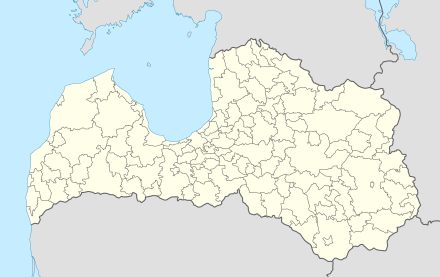Dobele Castle
| Dobele Castle | |
|---|---|
| Zemgale, Latvia | |
|
| |
 Dobele Castle | |
| Coordinates | 56°37′20″N 23°16′22″E / 56.622171°N 23.272757°E |
| Type | Castle |
| Site information | |
| Condition | Ruins |
| Site history | |
| Built | 1335-1339 |
| Built by | Livonian Order |
| Materials | Brick, boulders |
Dobele Castle is a castle in the town of Dobele on the west bank of the river, in the historical region of Zemgale, in Latvia. Dobele was built in 1335 by the Livonian order on top of a more ancient castle.[1]
History
Place of the Dobele medieval castle was inhabited by Semigallians before and during Livonian crusade. On the hillfort was located administrative centre of the Dobele county and quite big settlement around it. It is first time mentioned in the written sources in 1254. During Livonian crusade heavy battles took place around the hillfort. It endured six sieges by Livonian order but crusaders never managed to conquer it. In 1279 crusader army from Kuldīga together with allied curonians attacked semigallian Dobele castle but was unable to conquer it. In winter 1280/81 Livonian order attacked Dobele castle under command of master Konrad von Feuchtwangen but attack failed. In winter 1288/89 large crusader army including allied estonians and latgalians under command of master Kuno von Hazzingenstein attacked Dobele. However they were able only to pillage and burn Dobele town but castle endured the siege. In 1289 after famine and crusader scorched earth policy to the whole region semigallians burned their Dobele castle and migrated to Lithuania. Thus Dobele castle was one of the last semigallian fortresses in the territory of Latvia.
Livonian order built stone castle on the abandoned semigallian hillfort in the years 1335-1347. Small craftsmen and merchant settlement soon developed around castle. Until 1562 castle was a seat of the Dobele komtur. In the 16th and 17th centuries several regional assemblies (landtag) were held in the castle. In 1621 and 1625 castle was occupied by Swedish troops under king Gustav II Adolf. From 1643 until 1649 castle was a residence of the widow of the Duke of Courland Elisabeth Magdalena who lived there together with her foster son, future duke- Jacob. During Polish-Swedish wars castle was occupied by swedes in 1658. After the war it was partly restored by duke Jacob Kettler. During Great Northern War castle was again occupied by swedes in 1701. King of Sweden Charles XII stayed in the castle for the six days. During war castle was heavily devastated and was not restored. It was completely abandoned in 1736 and since then has fallen into ruin.
In 1915 at the foothill of the castle German emperor Vilhelm II inspected units of the German army.
See also
References
External links
 Media related to Dobele Castle at Wikimedia Commons
Media related to Dobele Castle at Wikimedia Commons
Coordinates: 56°37′20″N 23°16′22″E / 56.622171°N 23.272757°E